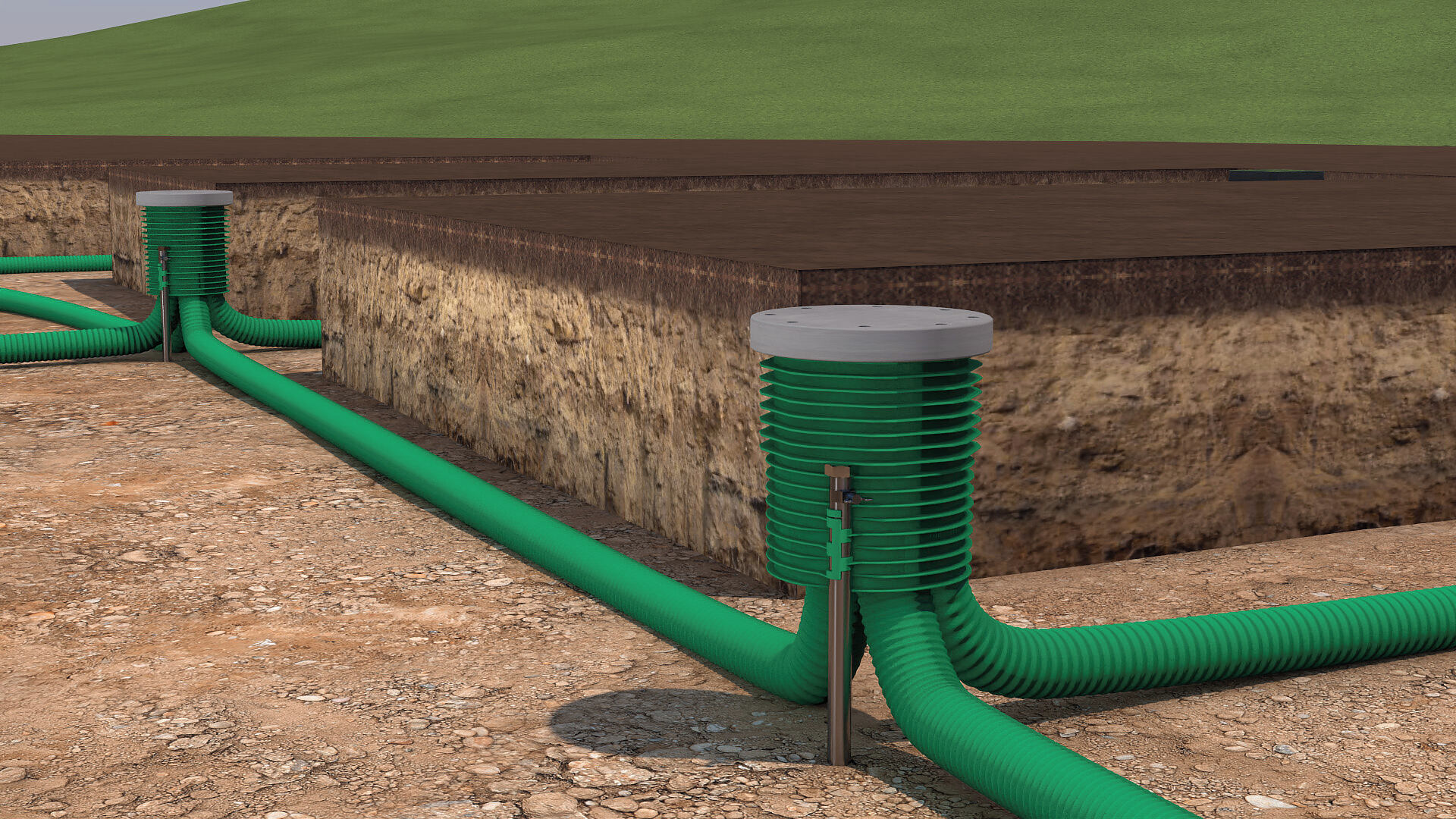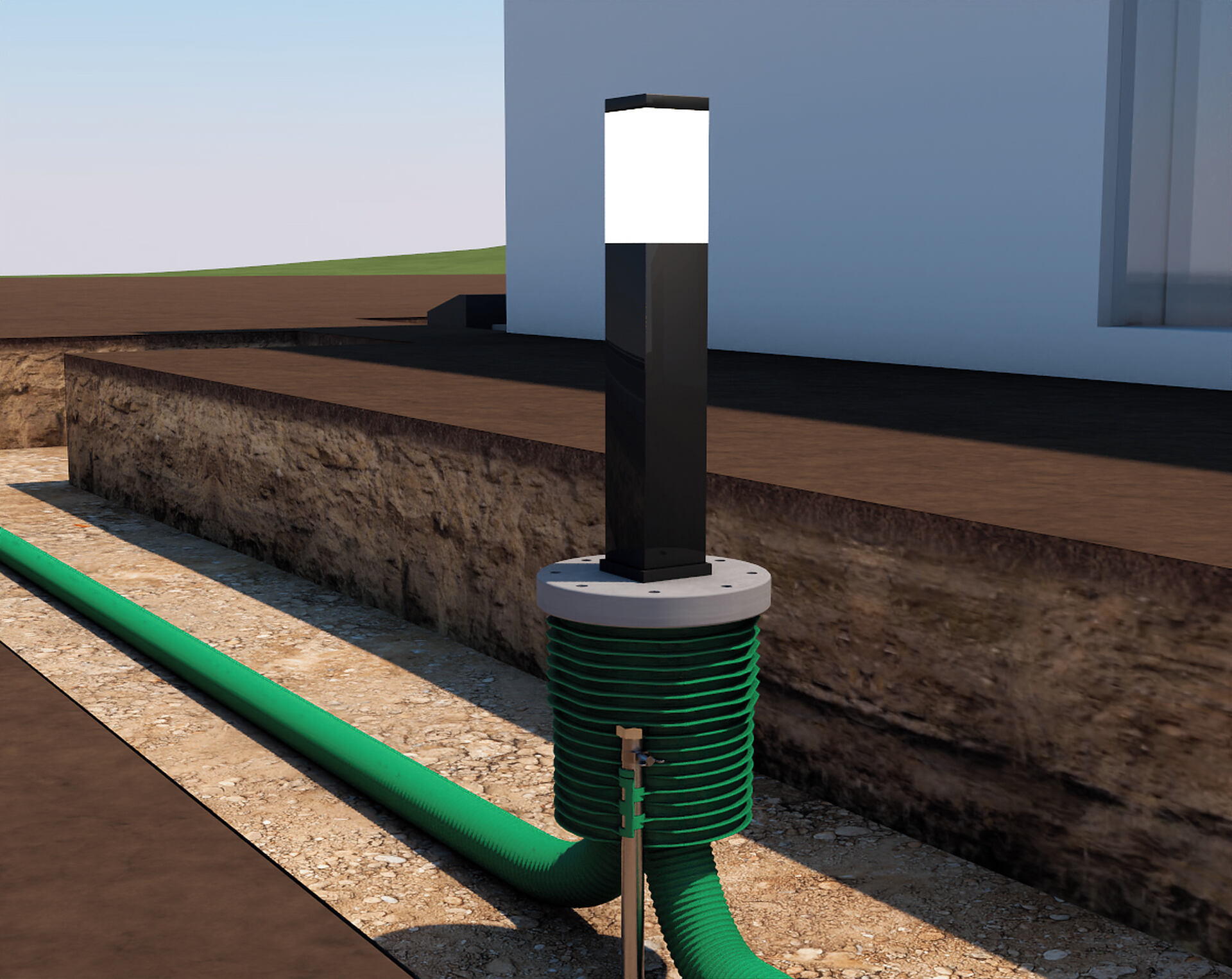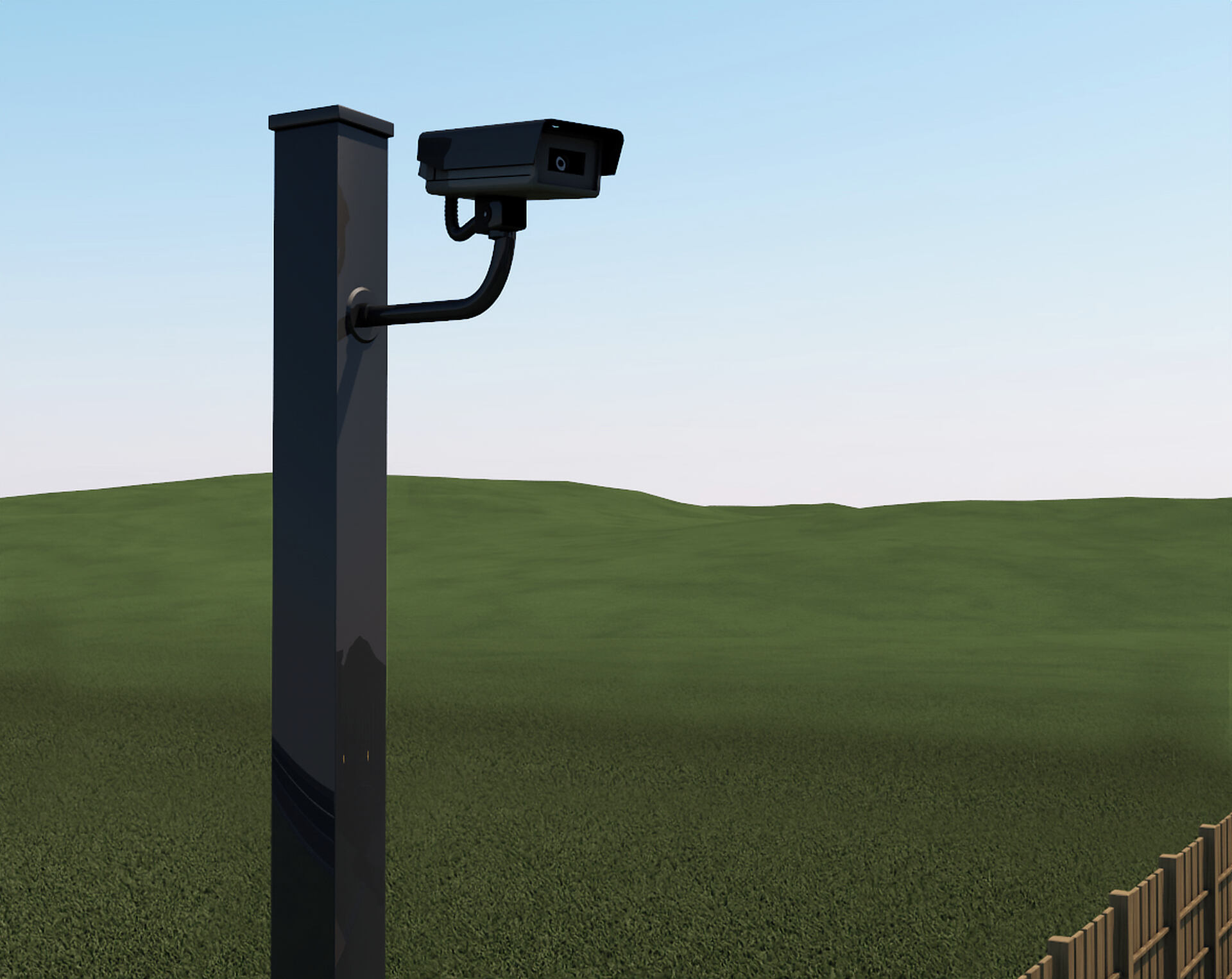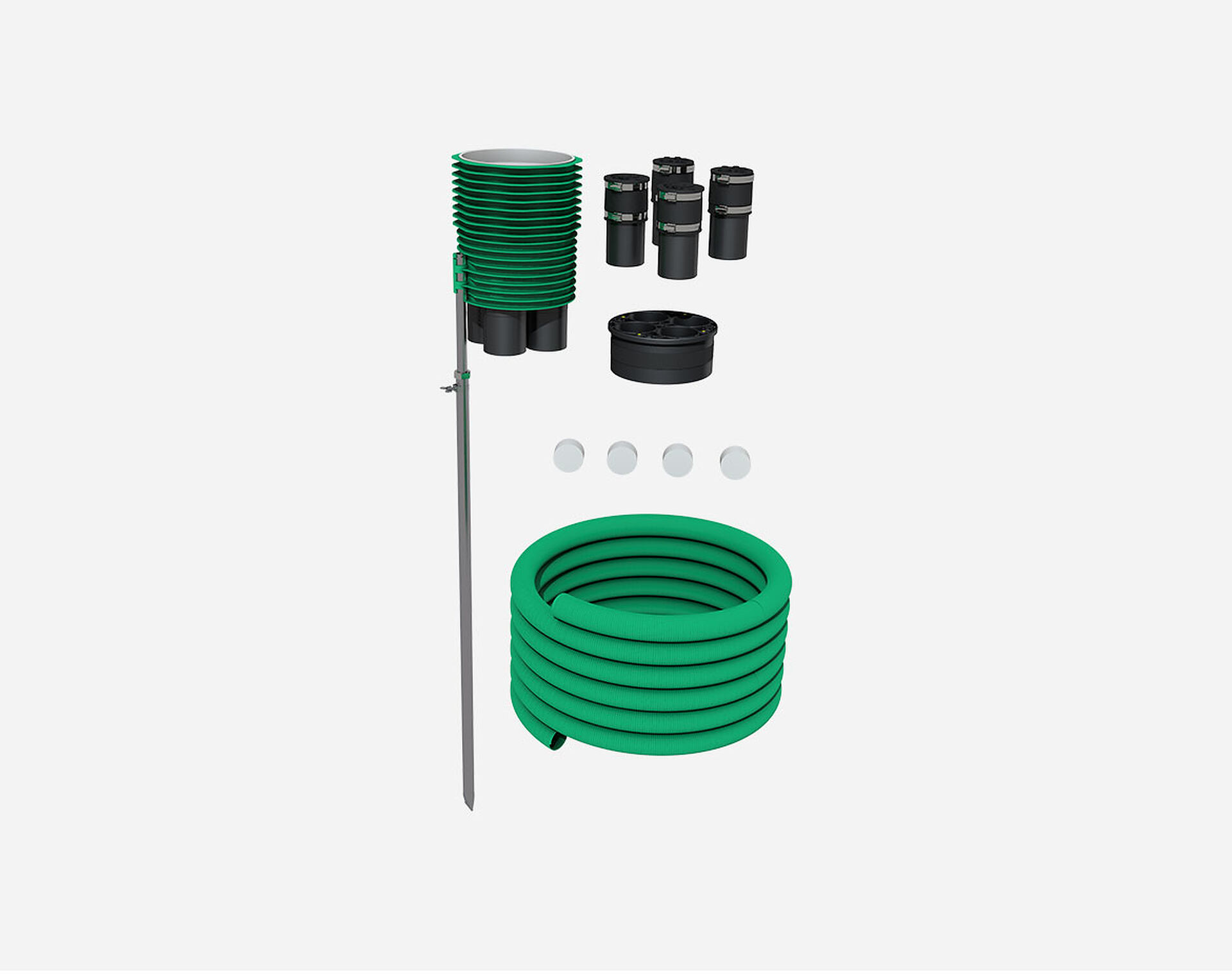Building packages
For the planning and distribution of electricity and telecommunications in the garden of the building, our ETGAR builder's packages offer the optimal foundation.
ETGAR is installed in the technical room, near the electrical (main) or sub-distribution, and is already poured into the concrete with when creating the floor slab of the building. Flexible empty pipes lead from this house design under the floor slab in all directions of the future garden plot. Thereby the ETGAR building owner package covers naturally all important technical requirements such as the dampness and radon protection of buildings.From this point on, one is completely flexible as to how to proceed with the garden planning.
The ETGAR extension and extension sets are the extension sets for the ETGAR builder's package. Once the house is completed, at some point it is time to move on to the exterior landscaping of the property.
Now you can simply extend the access points already set during the construction phase and guide them to the desired location, branch off again, or simply leave them blind closed to be able to use the access at some later date.

Wall version

ETGAR building package for multi-line building service outlets
for buildings with a basement
HAW-M ETGAR BHP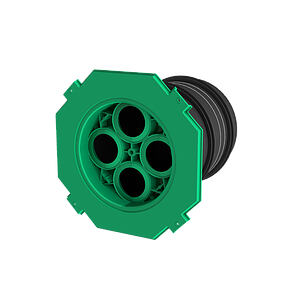
ETGAR wall sleeve for building services outlet
for ETGAR BHP
HAW-M ETGAR FR
ETGAR building package for single building service outlets
for buildings with a basement
HAW-E ETGAR BHP
ETGAR building package for single-line building service outlets with module 8
for buildings with a basement
HAW-E ETGAR BHP SET
ETGAR exterior sealing element for single-line building service outlet
for ETGAR building package for single-line building service outlet
HAW-E ETGAR AD
Electric cable entry
for buildings with or without a basement
EKDFloor version
Hauff-Technik Building Packages for Multi-Utility Installations
Hauff-Technik provides comprehensive building packages specifically designed for multi-utility installations, enabling the integration of various supply lines into your property. These packages allow for the installation of utility connections to the exterior of your home at any time, directly linking to the building's technical systems. This flexibility ensures that both electricity and telecommunications connections can be easily established on your property, accommodating future expansions or adjustments as necessary. With these building packages, homeowners can effectively prepare their properties to meet modern utility requirements, enhancing overall functionality and convenience.
Advantages of Multi-Utility Installations
Multi-utility installations offer a significant advantage over single-utility setups by allowing multiple types of utility lines to be routed outdoors through a specialized system. In contrast, single-utility systems are limited to accommodating only one type of line. This flexibility is particularly beneficial for retrofitting existing buildings, making it easier to integrate new services as needed. Furthermore, the underground installation method enhances the protection of utility lines from potential damage and unauthorized access. By utilizing dedicated pipe penetrations, these systems ensure that utilities are securely buried, reducing the risk of external factors compromising their integrity.
Applications for Multi-Utility Installations
Multi-utility installations are crucial when setting up electrical devices or systems on a property. These scenarios can vary widely, but common applications include garden and pathway lighting. With the increasing shift towards electric mobility, most homes will require an electric vehicle charging station that must be connected to the building's electrical system.
Additionally, security systems, such as cameras and sensors, are often installed away from the main building, making multi-utility installations a practical solution. These installations also facilitate the routing of various utility lines, including network cables for connecting Wi-Fi access points in outdoor areas or for connecting smart heating systems located in separate buildings. By enabling the seamless integration of different utilities, multi-utility installations significantly enhance both the functionality and convenience of residential properties.
Hauff-Technik Building Packages � Complete Sets for Multi-Utility Installations
Hauff-Technik offers a variety of building packages designed for multi-utility installations, specifically tailored for integration during the construction phase. The ETGAR building package is intended for homes without basements, allowing the system to be directly embedded into the building's foundation slab.
The core component of this system is the base unit, which is cast into the foundation within the house. This base unit features outlets for the various utility lines, which are introduced through a sealing plug. These plugs accommodate different types of utility lines, enabling the introduction of electrical and telecommunications cables with diameters ranging from 5 to 40 mm
Sealing is achieved through the sealing plug, which first secures the base unit and then seals each utility line directly at the entry point. This ensures that the entire system is gas and water-tight from the inside of the house, preventing any radon from the ground from infiltrating the interior.
The base unit connects to PE corrugated pipes, each equipped with four 75 mm diameter outlets. These pipes are not only gas and water-tight up to 0.5 bar, but they are also resistant to rot and UV exposure. The PE corrugated pipes can extend up to 30 meters in length, and with the ETGAR extension set, they can be further elongated. This modular design allows for customizable lengths of supply lines leading into the exterior.
With four multi-utility lines, it becomes possible to reach various points on the property, whether it be the garden behind the house, the area in front, or any other designated location. At the desired endpoint, the 2LINE G-BOX from the ETGAR series is installed in the ground, connecting the underground corrugated pipes to deliver the utility lines precisely where they are needed. Additionally, these corrugated pipes can also serve as empty conduits, enabling future installations of power or network cables to the exterior without requiring extensive construction or earthworks. This flexibility not only simplifies the installation process but also enhances the overall functionality of the utility system in your home.
Expanding Multi-Utility Installations
Hauff-Technik provides expansion sets for its multi-utility system, enabling homeowners to establish additional connection points throughout their gardens. These sets include extra 2-LINE G-BOXes and PE corrugated pipes, which allow for the creation of more distribution and endpoint connections on your property without the need to install new electrical cables from the house. The 2-LINE G-BOXes serve as distribution centers, delivering power to specific locations with minimal effort.
As modern technology evolves, new application scenarios continue to emerge. This includes the installation of heat pumps and the integration of charging stations for smart lawn mowers. Setting up a Wi-Fi antenna on the terrace is also made simple. By planning for a multi-utility installation during the construction phase, homeowners can seamlessly implement such projects later, all at very reasonable costs.
Help us improve our website service.
Where would you place yourself?
Architect & designer
Wholesaler
Telecoms
Utility company
Installer
Construction company

Please choose your region




-
 Belgium
Belgium
-
 Česko
Česko
-
 Danmark
Danmark
-
 Deutschland
Deutschland
-
 España
España
-
 France
France
-
 Global
Global
-
 Hrvatska
Hrvatska
-
 Italia
Italia
-
 Luxembourg
Luxembourg
-
 Magyarország
Magyarország
-
 Nederland
Nederland
-
 Österreich
Österreich
-
 Polska
Polska
-
 Schweiz
Schweiz
-
 Slovenija
Slovenija
-
 Slovensko
Slovensko
-
 Sverige
Sverige
-
 United Kingdom
United Kingdom
-
 Global
Global
-
 USA
USA
-
 Global
Global
-
 India
India
-
 中国
中国
-
 Global
Global
-
 الإمارات العربية المتحدة
الإمارات العربية المتحدة




























